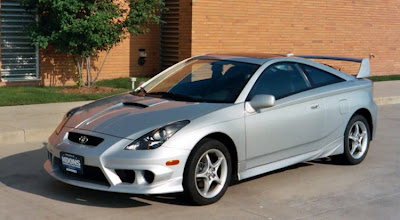Wednesday, August 31, 2011
2011 Hyundai Sonata Hybrid Wallpapers
Though an upcoming 429-horsepower 5.0-liter V8 might suggest otherwise, Hyundai intends to lead the industry in fuel economy. As recently as 2005 this would have seemed a pipe dream. That year’s Hyundai Sonata automatic managed fuel economy ratings of only 19/27 MPG from the EPA (2008+ system), well below the 21/31 achieved by the Honda Accord and Toyota Camry. The 2011 Hyundai Sonata Hybrid does far better: 22/35. But the glory, of course, goes to hybrids, and so the Sonata will soon be available in hybrid form. The projected EPA numbers: 36/40. Is Toyota’s hybrid leadership in danger?
By arriving late to the hybrid party, Hyundai had ample opportunity to learn from others’ failures. One lesson: car buyers expect a hybrid to look different. Hyundai’s solution: graft an exceedingly ugly nose, complete with an XXL hexagonal lower grille, onto the Sonata. LED tail lamps take the other end of the car up a notch. Exhaust is the opposite of green, so the pipe is concealed. The exterior tweaks aren’t solely for aesthetics: they also reduce the drag coefficient from an already Volt-beating 0.28 to a Prius-tying 0.25.
The interior is standard stylish 2011 Hyundai Sonata Hybrid, with a few notable exceptions. An “eco guide” replaces the tach. The trip computer receives a mild upgrade. The optional leather upholstery gains perforations. The optional sunroof gains a rear panel—an odd choice since this should reduce efficiency by adding weight and increasing the load on the AC. And a surprise: the HVAC airflow control is properly three pieces rather than one, so it provides the function as well as the form of the Volvo control that clearly inspired it. As in other hybrids, trunk space takes a hit, dropping from 16.4 to 10.7 cubic feet.
For their hybrids, Ford and Nissan followed the Toyota HSD model. Hyundai has taken a different route. Where HSD employs a planetary gearset CVT, Hyundai retains the regular Sonata’s six-speed automatic—but not quite all of it. Unlike in the late, unlamented Honda Accord Hybrid, which similarly sandwiched a (much weaker) electric motor between a conventional gas engine and a conventional automatic transmission, there’s no torque converter. Instead, the electric motor handles transitions to and from a dead stop. The Sonata Hybrid’s engine also receives one substantial modification. As in the HSG, the 2.4-liter four runs through an Atkinson cycle to virtually lengthen the ignition stroke and so squeeze a bit more energy out of each cycle. The cost of closing the intake valves part way through the compression stroke: 29 peak horsepower (now 169).
The innovation that makes this unique powertrain possible: a clutch between the engine and electric motor. The Honda Accord Hybrid’s engine could not be declutched from the rest of the powertrain, so that car could not run on electric power alone and had to retain the inefficiencies of a torque converter. By declutching the engine, the 2011 Hyundai Sonata Hybrid can (allegedly) cruise up to 62 MPH on electric power alone.
Finally, Hyundai opted for a lithium-polymer battery rather than the NiMH batteries employed by the others. The lithium-polymer batter is more compact and lighter. Partly as a result the Sonata Hybrid weighs only 3,457 pounds, over 200 less than the Camry and Fusion. Downsides? Hyundai isn’t suggesting any, but the newer technology is less proven and can’t be cheap.
How does it behave? Total gas-plus-electric power output is a little higher at the peak, and notably higher at low rpm, where the 40-horsepower electric motor contributes 151 pound-feet of twist. So, like its direct competitors, the Sonata Hybrid feels plenty quick. The drivetrain sometimes plays a touch rough at low speeds—perhaps the clutch engaging and disengaging—but otherwise behaves well. The conventional automatic feels so much more normal than a CVT—it can even be manually shifted—that the deleted tach is actually missed.
So what’s not to love? Fuel economy. I barely touched 40 in a largely highway stint. When did 40 become disappointing? When the 274-horsepower Sonata 2.0T achieved the same. In suburban driving, I managed “only” 31.3 despite a very light foot. The 36 promised by the EPA numbers wasn’t happening. And while electric-only operation might be possible up to 62 MPH, it doesn’t actually happen unless you’re extremely light on the gas. A tailwind and/or a downhill slope might also be required. The Toyota-type system seems to have a clear advantage in city and suburban driving. In these conditions the Ford Fusion Hybrid tops the Sonata by about 10 MPG. Drive the 2011 Hyundai Sonata Hybrid aggressively, and suburban fuel economy falls below 20. A Ford Fusion Hybrid still managed 27 when subjected to my lead foot.
Better driving aids might help, or would at least be more entertaining. Toyota, Ford, and others have been providing ever more precise and detailed feedback to help drivers adjust their driving style to maximize efficiency. In contrast, the 2011 Hyundai Sonata Hybrid's “eco guide” is little better than the MPG gauge BMW has been offering for decades. A vine that grows and loses leaves against a background that changes color, both based on your driving style, can be summoned up, but it’s as useless here as it is elsewhere. Sought but not found: some indication of the limits of the regenerative braking system, beyond which the conventional brake rotors cut in to convert kinetic energy into heat.
With curb weight up just a couple hundred pounds, and with the steering electrically-assisted in both cases, the 2011 Hyundai Sonata Hybrid steers and handles much like the regular Sonata. Meaning better than average, and bordering on fun to drive, but not as taut as the Fusion Hybrid. With the optional 17-inch wheels the ride is more jittery than the Sonata Limited’s. The likely culprit: while the tire size is the same, 215/55VR17, the Limited wore Hankook H431s while the Hybrid is shod with Kumho Solus KH25s. Even so, the ride-handling balance could be the best in the segment, with sharper handling than the Camry and a smoother ride than the Fusion.
Taken by itself, the 2011 Hyundai Sonata Hybrid is a very good, even excellent car. But, even more than most hybrids, it makes little rational sense. Despite the lofty promise made by the EPA city figure, the hybrid system doesn’t seem to improve fuel economy nearly as much as the Toyota-type system in city and suburban driving. It fares better on the highway—40 MPG for a roomy, semi-lux sedan is certainly admirable—but must then contend with the regular Sonata, which does nearly as well, even with the 274-horsepower turbocharged engine. Pricing for the Hybrid hasn’t yet been announced. If Hyundai charges $2,500 or less extra for the hybrid bits, which will be cut in half by a $1,300 tax credit, and the technology turns you on more than the front end turns you off, then by all means go for it. Otherwise, the regular Sonata is a better bet.




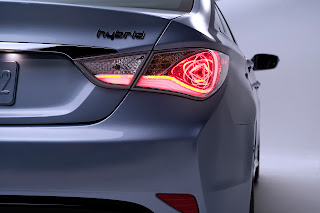
Tuesday, August 30, 2011
The 10 Greatest Muscle Cars of All Time
 |
| Muscle Car Racing |
1. 1967 Shelby Mustang GT500
 |
| Ford Shelby GT500 - Top 1 |
Mustang Shelby GT500 was created by Carroll Shelby. and introduced in 1967. This shows the type of car the GT350 GT500 joined the showroom floor and offers a 428 cubic inch engine Police Interceptor engine power conservatively rated 355 horsepower. The car is designed as a road vehicle with a size larger than the GT350. Because of this, and odds are ignored during the GT350, GT500 is an instant hit, as the remains to this day.
2. 1966 Shelby Cobra 427
2. 1966 Shelby Cobra 427
 |
| 45 Years of Shelby Mustangs - Top 2 |
Car Shelby Cobra 427 is a type of fast car that became an icon of classic American muscle car. Based on the lightweight AC Ace British roadster, Cobra is the idea of car legend Carroll Shelby. Basically, this car was created by shoehorning a Ford engine under the hood 427 giant air conditioner. The end result is a scary fast roadster that is also very successful on the track. In some auctions the car, including the world of cars with high value fresh.
3. 1969 Chevy Camaro Z28
The first-generation Chevrolet Camaro Z28 is designed to evoke emotions in the hearts of fans. Guise Z28, '69 Camaro that has a size of a small-block 302 cubic inches and is designed for Trans-Am races. Chevy Camaro Z28 is powered 290 horsepower engine. This car showing F41 sport suspension, front disc brakes standard and Muncie 4 speed box. This car is big enough, but it can run at high speed.
4. 1970 Chevelle SS 454
Car-engine-powered 1970 Chevelle SS 454 450 horses. The car has an engine size is 454 cubic - about 7.4 liters - is a lot of machines and produces amazing energy. This car is very popular in the era of the 1970s. LS6 upgrades made a spectacular leap for added strength. Cars, and the machine was done, in essence, represents the limit of the muscle car war powers, and the car is still the largest production output to date.
5. 1970 Plymouth Hemi Cuda '
The results of the redesign of the 1970 Plymouth Barracuda is a type of high-powered V8 engine with the engine output to 425 horsepower. This car has become very popular because of your run speed is incredible. 426 Hemi Cuda 'to bring down a quarter mile in 13 seconds down. 1970 Plymouth Hemi Cuda cars' is very popular among street racers.
 |
| Muscle Cars Are Back - Top 3 |
The first-generation Chevrolet Camaro Z28 is designed to evoke emotions in the hearts of fans. Guise Z28, '69 Camaro that has a size of a small-block 302 cubic inches and is designed for Trans-Am races. Chevy Camaro Z28 is powered 290 horsepower engine. This car showing F41 sport suspension, front disc brakes standard and Muncie 4 speed box. This car is big enough, but it can run at high speed.
4. 1970 Chevelle SS 454
 |
| Woodward Dream Cruise Muscle Cars - Top 4 |
 |
| 1970 Plymouth Hemi 'Cuda - Top 5 |
6. 1965 Pontiac GTO
Potiac GTO car known by the nickname "Goat". Muscle car was delivered on era1965 with block 389 cubic inch engine. This car has an output of 335 horsepower. Cars Potiac GTO known as bond options with Tri-Power engine are good for 25 extra horses. The car is capable of speeds of 60 mph in under six seconds. His trademark was found on the brake and direction than the standard GTO vacancies for steering control. Muscle car is quite comfortable to drive.
 |
| 1965 Pontiac GTO - Top 6 |
7. 1970 Mustang Boss 302
It is a severe muscle car with a high-rev V8 Boss 302, which is underrated at 290 horsepower Camaro to meet arch-rival. Made for the excitement in the race. This car can reach speeds of 60 mph in seven seconds and zero to regularly clock sub-15-second quarter mile. As a reader poll described his desire to rev high, "After the hooks car and the revs rise above 3500, you better hold on for dear life."
8. 1969 Dodge Charger
Car Charger Type 69 is very popular on television in the 1980s. The car is usually painted orange and nicknamed the "General Lee". Coupe Car has become famous and become a star television show "The Dukes of Hazzard." Motor car on 425 horses, weighing half a ton machine.
9. 1968 Pontiac Firebird Coupe
Pontiac Firebird name may inspire images of coupe cars in the 90s, or maybe the hood painted icons of the 1980s. Currently, the name Firebird recalls Burt Reynolds' classic film "Smokey and the Bandit"? however, Firebird back sooner than a good example. The car is a close cousin of the Chevrolet Camaro, 1968 model machine that offers a variety of machines, including a 400 cubic inch V8 roaring with 335 horsepower.
 |
| The Boss Is Back Off-Road Mustang Unveiled - Top 7 |
8. 1969 Dodge Charger
 |
| Rollin' It Retro - Top 8 |
9. 1968 Pontiac Firebird Coupe
 |
| 1968 Pontiac Firebird Coupe - Top 9 |
10. 1970 Buick GSX
GSX 1970 is the type of car coupe Buick GS 455 are strong and have large-size blocks. This car has a force of up to 360 horsepower and 510 lb-ft of torque monumental. Cars manufactured by General Motors in 1970, was only available two warnya yellow and white with racing line-gars mandatory, of course. Just 678 coupes were produced.
 |
| Rock n Roll Cars of the King Top 10 |
Monday, August 29, 2011
Road Runner Wikipedia Overview - Cartun and Muscle Car
 |
| The Road Runner Show |
 |
| The Road Runner Muscle Car |
When we talk about the "Road Runner" maybe you remember a movie with a series of cartoon characters from Looney Tunes and melodies Marie. Star character in long-running series of theatrical short cartoons (16 to the first written by Malta) and the occasional made-for-television cartoons. two cartoon character Wile E. is known Coyte also known as "The Coyte" and Road Runner. In 1949, Coyte the character created by animation director Chuck Jones called. The film was made in the home of Warner Bros. movie, as the model for the adventure of the film is the work of the famous writer named Michael Maltese.
 |
| Plymouth Road Runner Superbird |
 |
| Road Runner Cartun Picture |
Coyote separately appeared as an antagonist of five errors Rabbit shorts: Operation: To Hare is Human, Rabbit Rabbit, Love it, Hare Hurry in width and Compressed Hare. Road Runner expressed only by the sound signatures, "Meep, Meep" and the occasional sound of the language. The "Meep, Meep", recorded by Paul Julian. While he is generally silent in shorts Coyote-Road Runner, he speaks with an accent on fine solo show (except for the Rabbit Hurry in width), is presented as "super-genius Wile E. Coyote", voiced by Mel Blanc.
 |
| Wile E. Coyote - Cartoon Star |
For now, the 48 cartoons that have been done with these characters (including three short CGI), partly by Chuck Jones.
 |
| The Road Runner Cartoon |
Coyote Jones books by Mark Twain thinning, where coyotes Twain described as "frame, long and thin, sick and sorry-looking" "living, breathing allegory of Want. He is always hungry." Jones said he created the cartoon Road Runner-Coyote cartoons as a parody of cat "traditional and mouse", as Tom and Jerry, who will work in the series of Jones as a director after his career.
 |
| RoadRunner Real Bird Photo |
GMC Acadia Wallpapers
A new, premium Denali model joins the GMC Acadia lineup for 2011, adding a new dimension of luxury and exclusivity to this popular crossover. It brings the distinctive Denali design elements, including a chrome honeycomb grille and monochromatic exterior color cues, along with exclusive fascias, high-intensity discharge headlamps and unique interior features. “The GMC Denali models have come to stand for luxury and exclusivity, and that’s just what customers will get in the new Acadia Denali,” said Lisa Hutchinson, GMC product marketing director. “The decision to develop an Acadia Denali was made quickly within the new GM in response to customer and dealer demand for a Denali version ever since the launch and success of the Acadia.”GMC's popular, eight-passenger Acadia continues in 2010 to win over customers seeking the spaciousness and capability of an SUV with a smooth ride and responsive handling of a crossover.
* USB connectivity in center console, enabling stored audio files to play through the audio system and battery charging for some handheld devices
* Yukon Denali-style roof rack
* Cashmere interior availablePowered by a direct injected 3.6L V-6, it is offered in SLE and SLT trims. All-wheel drive and SLT-1 and SLT-2 equipment packages are available. A comprehensive safety system includes six standard air bags and standard StabiliTrak electronic stability control system with rollover mitigation technology.GMC’s popular Acadia continues to win over customers seeking the spaciousness and capability of an SUV with a smooth ride and responsive handling of a crossover. Nearly 73,000 were sold in 2007 and sales increased more than 75 percent in the first quarter of 2008 – in a segment that was up only 9 percent over the first quarter in the previous year.For 2009, Acadia receives an enhanced version of the 3.6L V-6 VVT engine that uses gasoline direct injection technology to help produce more power, greater fuel economy and increased towing capacity than the ’08 model. The engine is paired with Acadia’s fuel-saving six-speed automatic transmission.

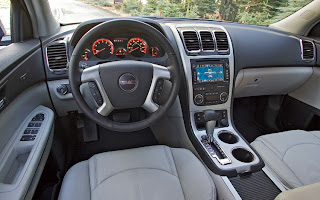
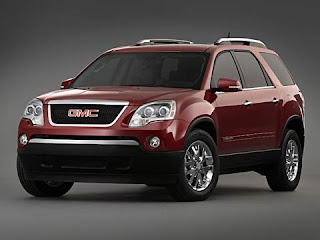


2012 Infiniti FX50 Pictures
The all-new five-passenger SUV rides on a wheelbase that has been elongated by 1.4 inches, and the top-of-the line 2012 Infiniti FX50 is powered by an all-new 5.0 liter V8 mated to a new seven-speed automatic transmission: a first for Infiniti.
The transmission can be shifted via steering column-mounted paddles, and downshift blip the throttle to match revs during spirited driving.
The newly developed 5.0-liter V8 that trumps the 4.5-liter V8 it replaces by 70 horsepower and 34 lb-ft of torque, with its rating of 390 horsepower and 369 lb-ft. It is only available with Infiniti's advanced ATTESA-ETS (Advanced Total Traction Engineering System for All Electronic Torque Split) all-wheel drive system. The new engine has better overall fuel economy than its predecessor as well, and is rated at
Safety systems on the 2012 Infiniti FX50 in both trims include Brake Assist and Electronic Brake-force Distribution, as well as traction and stability systems. Optional is Intelligent Brake Assist for warning of a frontal collision and capable of automatic braking, Distance Control Assist (DCA) for keeping pre-set distances from the vehicle ahead in heavy traffic and a Lane Departure Warning/Lane Departure Prevention system, which helps keep the FX in its lane.
Standard comfort and convenience fare includes Infiniti's Intelligent Key entry and vehicle start system, as well as optional Intelligent Cruise Control (Full Speed Range) and Around View Monitor system.
Standard lighting includes High Intensity Discharge (HID) headlights while LED taillights double as aerodynamic aids. All paints covering the FX's new, lighter body utilize Infiniti's Scratch Shield technology that uses sunlight to heat the clear coat and fill in any fine scratches it may have endured.
Inside, the base sound system is a Bose-designed, 11-speaker set-up with AM/FM band reception, a six-disc changer and XM satellite radio hardware. An optional hard-drive based audio and navigation system includes real time traffic information with an XM subscription, a 9.3GB digital juke box, iPod interface, CF card slot and a voice recognition system for controlling the climate control, navigation and audio system and phone.

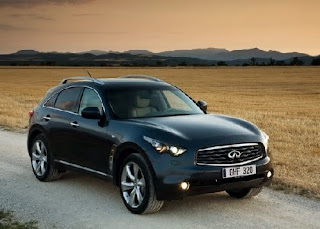

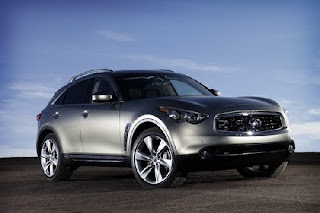

Volvo V70 Car Pictures
 The Volvo V70 is a mid-size five-door estate car / station wagon manufactured by Volvo Cars since 1996. It is closely related to the S70, S60 and S80 saloons, as well as the four-wheel drive Cross Country (XC) and XC70.
The Volvo V70 is a mid-size five-door estate car / station wagon manufactured by Volvo Cars since 1996. It is closely related to the S70, S60 and S80 saloons, as well as the four-wheel drive Cross Country (XC) and XC70.Since its inception, the V70 has evolved through three generations, with the second generation designed by Peter Horbury.
Toyota Celica Mix Cars
 The Toyota Celica name been applied to a series of coupes made by the Japanese company Toyota. The name is ultimately derived from the Latin word coelica meaning "heavenly" or "celestial".
The Toyota Celica name been applied to a series of coupes made by the Japanese company Toyota. The name is ultimately derived from the Latin word coelica meaning "heavenly" or "celestial".Throughout its life span the Celica has been powered by various four cylinder engines. The most significant change occurred in August 1985, when the car's drive layout was changed from rear wheel drive to front wheel drive. During the first three generations, American market Celicas were powered by various versions of Toyota's R series engines. The four-wheel drive turbocharged model (designated All-trac in the United States or GT-Four elsewhere) was produced from 1986 to 1999. Variable Valve Timing came in late 1997 Japanese models, and became standard in all models from 2000 on. Through seven generations, the model has gone through many revisions and design forks, including the Toyota Celica Supra (later known as the Toyota Supra). The Celica was available as notchback and liftback coupes, as well as a convertible.
Subscribe to:
Posts (Atom)















